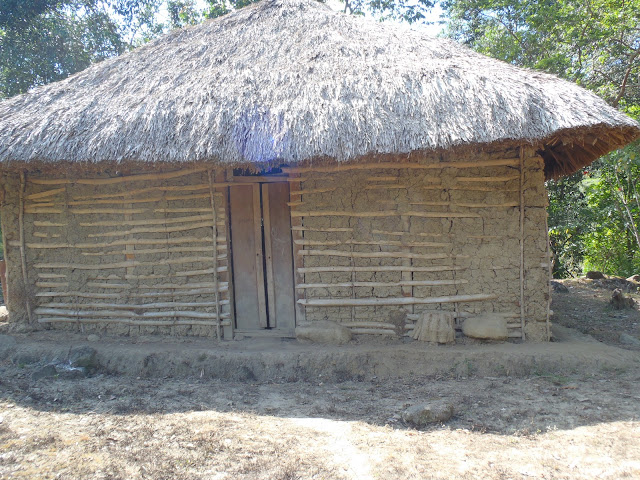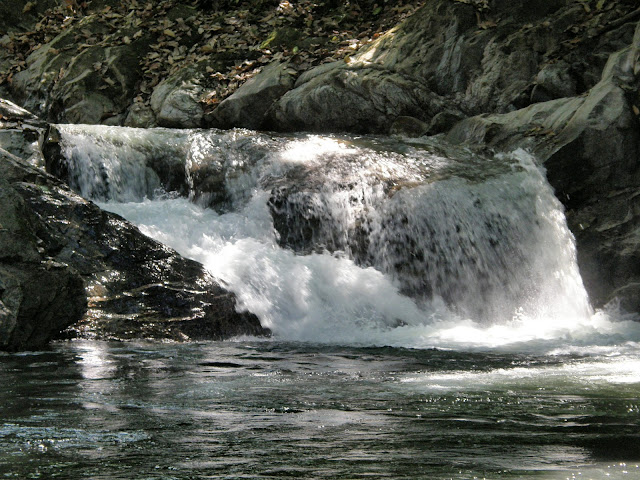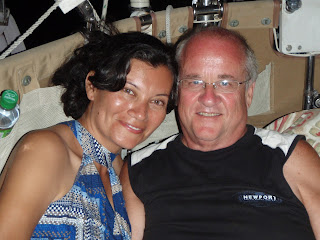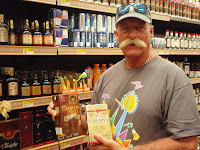Minca is a small town of about 500 hundred people 660 meters (about 2000 feet) above sea level, nestled in the foothills of the Sierra Nevada and hidden in lush vegetation. Guides say the 14 mile winding road is traveled in 25 minutes. I guess that was when the road still was free of potholes; it took us an hour on a very bumpy road, a beautiful drive though. The Sierra Nevada, in the shape of a pyramid, rises from the sunny coasts of the Caribbean tropics to the chilly, snow-capped peaks that reach a height of 17,000 (5775 m) feet above sea level, which makes it the highest tropical mountain in the world. Within just 30 miles/fifty kilometers the northern slopes descend from the snow capped peaks to the turquoise waters, tropical jungle shores and coral reefs of the Caribbean ocean.
Here you find trees of up to 40 meter (130 feet) heights. The Fauna supposedly they say is full of bears, deer and smaller species like armadillos, hedgehogs, ocelots and monkeys. Didn’t see any but we did hear the roar of howler monkeys. Thousands of birds, insects and butterflies are at home in this tropical forest, we saw many colorful hummingbirds. Minca is an ecological paradise with uncountable rivers, waterfalls and immense green vegetation which hides the archaeological remains of its ancestors the Tayrona Indians. Today in the highlands you can still find indigenous people belonging to Kággaba (Kogi), Ijka (Arhuaco), Wiwa (Arzario) and Kankuamo tribes, direct descendants of the Tayrona Indians keeping up with all the traditions.
We stayed at a cute Finka (Ranch) “Sierra Sound” which is located right next to a river with a stairway down to the river bed for bathing, a very, very beautiful place.
You can stay at least a week here and hike each day a different path and find a different river or waterfall. We decided to visit the Arimaka Fall an hour hike up the mountain (years ago it was used by the Indians for religious ceremonies). On the way up the hill we ran into two local women chatting along the path, one was on her way home with her son and his donkey and motioned to follow her after I asked if this was the right way to the fall. She even offered us to ride the donkey which we declined. It was a fun walk up the hill and finally she pointed us into the direction of the waterfall while she headed another 25 minutes up the mountain to her home.


It was about another 10 minutes before we arrived at the entrance to the waterfall. A friendly farmer chopping down some weeds greeted us and stopped what his was doing and nodded for us to go ahead that he will catch up with us at the waterfalls as this was his coffee plantation. We followed the narrow path and found the waterfall or falls in a hidden valley surrounded with lush vegetation. We climbed the many stairs down and were in awe as we finally stood under the waterfall. Since it was almost noon I brought a bottle of wine and snacks out and we sat there enjoying it. There came Juaquin the plantation owner down the steep steps balancing a tray in his hand with 4 cups of his freshly brewed coffee, wow what a treat. I offered him some wine and cheese we still had and Andy gave his 4 year old son a breakfast bar he really enjoyed.
 Juaquin invited us to go swim in the waterfall and told us that the better bathing is in the fall above the Arimaka. Sid and Susan braved it into the water, brrrr it was cold.
Juaquin invited us to go swim in the waterfall and told us that the better bathing is in the fall above the Arimaka. Sid and Susan braved it into the water, brrrr it was cold.  |
| BRRRRR is it cold! |
 |
| Where is it?!! OH NO It's gone and I forgot to tie a string to it! |


We had all kinds of questions for him and his coffee plantation and so he invited us to his Finka. He showed us step by step all the processes of coffee making , all a lot of manual labor, including roasting the coffee, which each one of us was taking part, then he took a hand cranked grinder out, ground the coffee we just had roasted and made us some more coffee, wow what a wonderful flavor especially sweetened by panela (raw cane sugar).
 |
| Finka Esperanza |
 |
| Drying coffee beans |
 |
| Juaquin roasting coffee |
 |
| Charcoal stove |
 |
| A real Redneck |
On any hike you will be able to find a coffee plantation here, each with different methods. I always thought that coffee grows on bushes not on trees, here they are all wild old trees and one had to climb the tree on steep hills to harvest the beans.
Rob was mentioning to us that he wanted to find some coca leaves so I asked the guy if they grow it in this are. Juaqin then started to tell us about coca and the Indians and invited us on a walk to visit Samuel one of the Arhuaco Indians who lives in the rain forest not far from him. It was a good 30 minutes walk when we arrived at his Finka. Joaquin told us also that the Mamas the spiritual leaders of the Kogi are getting together here in a few days for rituals. Koqui/Kogi Mamas are chosen from birth and spend the first nine years of childhood in a cave in total darkness learning the ancient secrets of the spiritual world or Aluna. They are the priests and judges who control Kogi society. Their culture it’s fascinating Samuel was quite excited to meet us and showed off his Indian outfit that he put on especially for us to see and allowed us to take pictures for a donation of course.
He is really proud of his ancestry and we felt pretty honored to be able to visit him and get such an insight. He brought us over to a coca bush and explained what they do with it. He took off his Lime container which is a small slightly pear-shaped gourd and perforated along the top. While all lime gourds consist of the same raw material, the wood of the stick which is inserted into it and is chosen by each owner for his own personality and identification. Samuel then explained that while slowly chewing some twenty or thirty toasted leaves, the man will wet the lower and slightly pointed end of the stick with saliva and will insert it into the gourd and he rotated it. Withdrawing the stick again he will put the adhering lime into his mouth. Immediately he will rub the stick around the top of the gourd in a circular motion. Eventually, this daily repeated action of rubbing the stick on the gourd surface begins to form a thin layered crust of yellowish-white lime that covers the upper part of the container.
He is really proud of his ancestry and we felt pretty honored to be able to visit him and get such an insight. He brought us over to a coca bush and explained what they do with it. He took off his Lime container which is a small slightly pear-shaped gourd and perforated along the top. While all lime gourds consist of the same raw material, the wood of the stick which is inserted into it and is chosen by each owner for his own personality and identification. Samuel then explained that while slowly chewing some twenty or thirty toasted leaves, the man will wet the lower and slightly pointed end of the stick with saliva and will insert it into the gourd and he rotated it. Withdrawing the stick again he will put the adhering lime into his mouth. Immediately he will rub the stick around the top of the gourd in a circular motion. Eventually, this daily repeated action of rubbing the stick on the gourd surface begins to form a thin layered crust of yellowish-white lime that covers the upper part of the container.
He gave us each a leaf to chew on. Of course our anticipation was enormous to find out what will happen as we had no idea what to expect……………… Absolutely nothing!!!
I think in general we are so miss informed about coca chewing. The coca plant was domesticated in Peru 7000 years ago and was traditionally used for initiations of marriages and to strengthen kinship and mainly medicinal purposes. It is also a common-practice for the Kogi Indians in the Andes, who, after puberty under go an initiation in which they are given coca leaves in small gourds. Within it, coca leaves are mixed with an alkali “Lime” produced from crushing seashells. When combined with saliva the alkaline will unleash the powers of the coca leaves which combats hunger, high altitude sickness and fatigue.
A Peruvian Study sh0ws that coca can help with asthma and depression or can be used as substitute for coffee to increase alertness (although coca does not have any caffeine). Further the study revealed an aid to metabolism of carbohydrates, combat diarrhea, increase sexual powers and also relieves muscle aches and inflammation. (Wow, I guess we came to the right place, I might be able to shed some weight!) They also make tea from coca leaves. A tea bag containing 1 gram of coca-leaf contains roughly 0.8 mg of Calcium, 3. 84 mg of Phosphorous, 1.26 mg of Magnesium and 30 mg of Potassium, as well as small percentage of Iron, including alkaloids, fiber, ash and vitamin A, B, C and E. Although the coca-leaf is grown in large amounts for cocaine production, it is also cultivated for tea-export from Peru. (I need to find me some of that).
After Samuel’s gourd demonstration we follow him into the ceremonial clay hut which took him 8 years to build; the same hut the ceremony took place a couple of days after our visit, wow. During the ceremony the Kogi produce Lime by burning sea shells on a small pyre carefully constructed with chosen splints. The fine white powder is then sifted into a ritual gourd which is carried by all men. In a special double-handed pottery vessel they then toast the coca leaves inside the temple (clay hut).
Small plantations of coca shrubs are found near all Kogi settlements, Coca shrubs are planted and tended by the men but the leaves are gathered by women. It is a part of the Kogi way of life, deeply involved with their traditions, religion, work and medicine
Small plantations of coca shrubs are found near all Kogi settlements, Coca shrubs are planted and tended by the men but the leaves are gathered by women. It is a part of the Kogi way of life, deeply involved with their traditions, religion, work and medicine
 The tribe known as 'Los Kogui' are today's custodians of the Tayrona culture. They have a population of approximately 12,000 people. The Kogi plant crops and live off the land. They prefer not to mix with outsiders. Few Colombians, or those from the outside worlds, are allowed to enter their mountains. They marry in their culture. The Kogi constantly move about from place to place, between their different abodes spread among the different levels of the Sierra Nevada mountain range. This is looked upon as taking care of their nutritional needs without abusing the environment.
The tribe known as 'Los Kogui' are today's custodians of the Tayrona culture. They have a population of approximately 12,000 people. The Kogi plant crops and live off the land. They prefer not to mix with outsiders. Few Colombians, or those from the outside worlds, are allowed to enter their mountains. They marry in their culture. The Kogi constantly move about from place to place, between their different abodes spread among the different levels of the Sierra Nevada mountain range. This is looked upon as taking care of their nutritional needs without abusing the environment. In 1990 the Kogi noticed a change in their environment and decided they must speak out to the rest of the world. The snows had stopped falling and the rivers were not full, so if their mountain was ill then the whole world was in trouble. The Mamas sent one of the Kogi who spoke Spanish to contact a British film maker who was in Colombia at that time. They asked BBC to make a film to tell the Younger Brother about their concern. It was called 'The Elder Brother's Warning 'or' The Message from the Heart of the World'. Alan Ereira, the producer, has also written a book about the Kogi called The Heart of the World. The film had a major impact on the Colombian Government and also on the grave robbers and things changed. The grave robbers felt that they should stop because they felt bad about disturbing their ancestors. There are now two Kogi members in parliament. To read more about the Kogi go to: http://www.crystalinks.com/kogi.html
In 1990 the Kogi noticed a change in their environment and decided they must speak out to the rest of the world. The snows had stopped falling and the rivers were not full, so if their mountain was ill then the whole world was in trouble. The Mamas sent one of the Kogi who spoke Spanish to contact a British film maker who was in Colombia at that time. They asked BBC to make a film to tell the Younger Brother about their concern. It was called 'The Elder Brother's Warning 'or' The Message from the Heart of the World'. Alan Ereira, the producer, has also written a book about the Kogi called The Heart of the World. The film had a major impact on the Colombian Government and also on the grave robbers and things changed. The grave robbers felt that they should stop because they felt bad about disturbing their ancestors. There are now two Kogi members in parliament. To read more about the Kogi go to: http://www.crystalinks.com/kogi.html
 On our hike back to Sierra Sound we relived the whole incredible day again, we all were just taken by what we all learned this day. We were so tired from all the walking we sank into the patio chairs and didn’t get out of them for hours. Partly because our legs were sore and the beer just tasted too good. All the fresh air gave us a good appetite and since they only had one order of the four cheese ravioli left we decided to share that for an appetizer. Ohmygosh was it good, not just were they home made and cooked to perfection but it was smothered in the creamiest sauce with flavor of cheeses and caramelized onions.
On our hike back to Sierra Sound we relived the whole incredible day again, we all were just taken by what we all learned this day. We were so tired from all the walking we sank into the patio chairs and didn’t get out of them for hours. Partly because our legs were sore and the beer just tasted too good. All the fresh air gave us a good appetite and since they only had one order of the four cheese ravioli left we decided to share that for an appetizer. Ohmygosh was it good, not just were they home made and cooked to perfection but it was smothered in the creamiest sauce with flavor of cheeses and caramelized onions.After a well deserved hot shower we all enjoyed a wonderful dinner overlooking the river with the acoustics of the water rushing over the river bed rocks. We retreated back into the sun chairs and enjoyed an after dinner drink. What a relaxing place!
Sid and I were up early on the terrace the following morning enjoying many cups of the wonderful local grown and brewed coffee and just enjoying this beautiful scenery. After a hardy breakfast we ventured off to the Pozo Azul Waterfall, an hour hike. Since I had some bites on my legs from the previous day we all sprayed extra Deep Wood Off on us. Arriving at the beautiful waterfall I noticed right away more of these red blood spots on my legs and sprayed even more juice on us. That should do. (When we arrived at Sierra Sound we met an English lady just leaving who’s legs were bitten up and told us that she got the bites at the waterfall and that the bug spray did not work. I thought to myself that she must have one without deet, well I was wrong, these little teeth with wings critters don’t care about deet).
We waded in the water and oh man was it cold, we were just in ankle deep water that was so cold that we got an ice-cream headache in our ankles, no swimming here that’s for sure. Those little wings with teeth called sancudos or jejenes (blackflies) you don’t even feel them when they bite. My legs were covered with red dots. Susan had a few bites but they left the guys alone. Hmmm I think they don’t like hairy legs, maybe we ladies need to stop shaving our legs?!!! The bites didn’t itch, well not immediately but 24 hours later oh man did they itch.
 We hiked a bit further up the mountain but realized that it was time to head back we had one more waterfall on the agenda before heading back to Santa Marta.
We hiked a bit further up the mountain but realized that it was time to head back we had one more waterfall on the agenda before heading back to Santa Marta. Las Piedras, which means, “rocks “,are just about a 5 minute walk from the Sierra Sound Finka. Las Piedras are two rivers coming together forming one, with the water passing quite rapidly over the rock formations. The unique thing about it is the temperature of the water in each of these rivers. One is very cold and the other is quite warm. It is a real beautiful area people visiting like to relax in the water, letting the water massage the body. This time of the year it’s a bit too chilly but we sat in it anyway enjoyed the water rushing by.
After another beautiful day in Minca it was time to say goodbye and head down the mountain again to Santa Marta. This was truly a wonderful experience we will treasure for years to come and who knows we may even return once more before we leave Santa Marta. Minca is a MUST visit. The ride back was fun too as we all had a rum and coke in our hands hanging out side the window so that we would not spill them with all the bumps. I didn’t help that the suspension of out taxi was shot. Sid in the front seat whenever he saw and opportunity to drink he yelled: “Drink! NOW!
After another beautiful day in Minca it was time to say goodbye and head down the mountain again to Santa Marta. This was truly a wonderful experience we will treasure for years to come and who knows we may even return once more before we leave Santa Marta. Minca is a MUST visit. The ride back was fun too as we all had a rum and coke in our hands hanging out side the window so that we would not spill them with all the bumps. I didn’t help that the suspension of out taxi was shot. Sid in the front seat whenever he saw and opportunity to drink he yelled: “Drink! NOW!
Thanks to Sandial’s satellite TV we were all able to sit on the Dock and watch Super Bowl. It was a fun party with a wonderful spread of food.

 |
| Mariah and Cruiser |
The winds have returned and for many more days we endured getting sand blasted. For a couple of nights we had a steady 30 to 35 knots of wind and gust up to 50.
Orestes on Milacura, we had met in Bonaire, sailed in from Cartagena. He had a miserable trip, lost his mainsail and one of the trampolines was trashed on his catamaran by the heavy seas. He was on his way to the Dominican Republic but decided to leave Milacura behind until the weather calms down some time in April. We had him and his crew Tito over for dinner and had a great time catching up. Orestes is the reason us cruisers found out that there is a marina in Santa Marta, thank you Orestes!
Orestes on Milacura, we had met in Bonaire, sailed in from Cartagena. He had a miserable trip, lost his mainsail and one of the trampolines was trashed on his catamaran by the heavy seas. He was on his way to the Dominican Republic but decided to leave Milacura behind until the weather calms down some time in April. We had him and his crew Tito over for dinner and had a great time catching up. Orestes is the reason us cruisers found out that there is a marina in Santa Marta, thank you Orestes!
The same day an English single hander limped into the marina. He was on his way from Curacao to Jamaica when he was tossed around so much that one of the high waves smashed him so violently that the house between the pontoons on his small cat had a whole smashed into it. Of course every time he smashed down a wave again more water came in. The poor guy didn’t think he was going to make it and is just so thankful to be here.
We’re definitely are not going to stick our noses into this kind of weather but are looking for a window to sail further south to Cartagena in the next couple of days or three or four. Monday might just be the day.
We’re definitely are not going to stick our noses into this kind of weather but are looking for a window to sail further south to Cartagena in the next couple of days or three or four. Monday might just be the day.
We finally managed to get Tim and Elena over for dinner. These two have just been wonderful to us and helpful in any way. Tim and Elena thank you so much for everything. (If you stop in Santa Marta don't forget to look them up and enjoy a delicious breakfast at their Cafe).
























































.jpg)